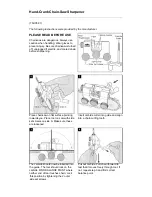
15
ENGLISH
Use only System M18 chargers for charging System M18
battery packs. Do not use battery packs from other systems.
Never break open battery packs and chargers and store
only in dry rooms. Keep dry at all times.
Battery acid may leak from damaged batteries under
extreme load or extreme temperatures. In case of contact
with battery acid wash it o
ff
immediately with soap and
water. In case of eye contact rinse thoroughly for at least 10
minutes and immediately seek medical attention.
Warning!
To reduce the risk of
fi
re, personal injury, and
product damage due to a short circuit, never immerse your
tool, battery pack or charger in
fl
uid or allow a
fl
uid to
fl
ow
inside them. Corrosive or conductive
fl
uids, such as
seawater, certain industrial chemicals, and bleach or bleach
containing products, etc., can cause a short circuit.
SPECIFIED CONDITIONS OF USE
The cordless impact wrench can be used to tighten and
loosen nuts and bolts wherever no mains connection is
available.
Do not use this product in any other way as stated for
normal use.
EC-DECLARATION OF CONFORMITY
We declare under our sole responsibility that the product
described under “Technical Data” ful
fi
lls all the relevant
regulations and the directives 2011/65/EU (RoHS), 2014/30/
EU, 2006/42/EC, and the following harmonized standards
have been used:
EN 62841-1:2015
EN 62841-2-2:2014
EN 55014-1:2017
EN 55014-2:2015
EN IEC 63000:2018
Winnenden, 2020-03-02
Alexander Krug
Managing Director
Authorized to compile the technical
fi
le.
Techtronic Industries GmbH
Max-Eyth-Straße 10
71364 Winnenden
Germany
DRIVE CONTROL
The drive control button is used to adjust the rotation
speed (RPM) for the application.
In
Auto Shut O
ff
Mode, the tool will drive forward at a
reduced RPM until the torque is achieved.
In reverse the tool will operate at full RPM to remove
fasteners at full torque.
OPERATION
Note: It is recommended after fastening to always check
the torque with a torque wrench.
The fastening torque is a
ff
ected by a wide variety of factors
including the following.
• State of battery charge – When the battery is discharged
voltage will drop and the fastening torque will be reduced.
• Operation at speeds – Operating the tool at low speeds
will cause a reduction in fastening torques.
• Fastening position – Holding the tool or the driving
fastener in various angles will a
ff
ect the torque.
• Drive accessory/socket – Failure to use the correct size
accessory or socket, or a non-impact rated accessory may
cause a reduction in the fastening torque.
• Use of accessories and extensions – Depending on the
accessory or extension
fi
tment can reduce the fastening
force of the impact wrench.
• Bolt/Nut – Fastening torques may di
ff
er according to the
diameter of the nut or bolt, the class of nut/bolt and the
length of nut/bolt.
• Condition of the fastener – Contaminated, corroded, dry or
lubricated fasteners may vary the fastening torques.
• Condition and base material – The base material of the
fastener and any component in between the surfaces may
e
ff
ect the fastening torque (dry or lubricated base, soft or
hard base, disc, seal or washer between fastener and
base material).
IMPACTING TECHNIQUES
The longer a bolt, screw, or nut is impacted, the tighter it will
become.
To help prevent damaging the fasteners or workpieces,
avoid excessive impacting.
Be particularly careful when impacting smaller fasteners
because they require less impacting to reach optimum
torque.
Practice with various fasteners, noting the length of time
required to reach the desired torque.
Check the tightness with a hand-torque wrench.
If the fasteners are too tight, reduce the impacting time.
If they are not tight enough, increase the impacting time.
Oil, dirt, rust or other matter on the threads or under the
head of the fastener a
ff
ects the degree of tightness.
The torque required to loosen a fastener averages 75% to
80% of the tightening torque, depending on the condition of
the contacting surfaces.
On light gasket jobs, run each fastener down to a relatively
light torque and use a hand torque wrench for
fi
nal
tightening.
BATTERIES
New battery packs reach full loading capacity after 4 - 5
chargings and dischargings. Battery packs which have not
been used for some time should be recharged before use.
Temperatures in excess of 50°C (122°F) reduce the
performance of the battery pack. Avoid extended exposure
to heat or sunshine (risk of overheating).
The contacts of chargers and battery packs must be kept
clean.
For an optimum life-time, the battery packs have to be fully
charged, after used.
TRANSPORTING LITHIUM BATTERIES
Lithium-ion batteries are subject to the Dangerous Goods
Legislation requirements.
Transportation of those batteries has to be done in
accordance with local, national and international provisions
and regulations.
• The user can transport the batteries by road without
further requirements.
• Commercial transport of Lithium-Ion batteries by third
parties is subject to Dangerous Goods regulations.
Transport preparation and transport are exclusively to be
carried out by appropriately trained persons and the
process has to be accompanied by corresponding experts.
When transporting batteries:
• Ensure that battery contact terminals are protected and
insulated to prevent short circuit.
• Ensure that battery pack is secured against movement
within packaging.
470 413 - M12FRAIWF-38, M12FRAIWF-12_EN62841.indd 15
470 413 - M12FRAIWF-38, M12FRAIWF-12_EN62841.indd 15
25.05.2020 13:23:31
25.05.2020 13:23:31
















































